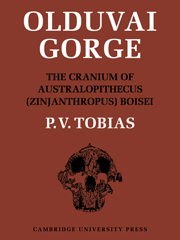Book contents
- Frontmatter
- Contents
- List of text-figures
- List of plates
- List of tables
- Introductory Note
- Foreword
- Editor's Note
- Acknowledgements
- I Introduction
- II Preservation and reconstruction of the cranium
- III The cranial vault
- IV The basis cranii externa
- V Certain critical angles and indices of the cranium
- VI The interior of the calvaria
- VII The thickness of the cranial bones
- VIII The endocranial cast of Zinjanthropus
- IX Metrical characters of the calvaria as a whole
- X The structure of the face
- XI The pneumatisation of the Zinjanthropus cranium
- XII The dental arcade and the palate
- XIII The pattern of dental attrition and occlusion, with comments on enamel hypoplasia
- XIV The size of individual teeth, absolute and relative
- XV The size of the dentition as a whole
- XVI The crown shape index of the teeth
- XVII The morphology of the teeth
- XVIII Summary of cranial and dental features of Zinjanthropus
- XIX The taxonomic status of Zinjanthropus and of the australopithecines in general
- XX The cultural and phylogenetic status of Australopithecus boisei and of the australopithecines in general
- References
- Index of persons
- Index of subjects
- Plate section
XIV - The size of individual teeth, absolute and relative
Published online by Cambridge University Press: 05 November 2011
- Frontmatter
- Contents
- List of text-figures
- List of plates
- List of tables
- Introductory Note
- Foreword
- Editor's Note
- Acknowledgements
- I Introduction
- II Preservation and reconstruction of the cranium
- III The cranial vault
- IV The basis cranii externa
- V Certain critical angles and indices of the cranium
- VI The interior of the calvaria
- VII The thickness of the cranial bones
- VIII The endocranial cast of Zinjanthropus
- IX Metrical characters of the calvaria as a whole
- X The structure of the face
- XI The pneumatisation of the Zinjanthropus cranium
- XII The dental arcade and the palate
- XIII The pattern of dental attrition and occlusion, with comments on enamel hypoplasia
- XIV The size of individual teeth, absolute and relative
- XV The size of the dentition as a whole
- XVI The crown shape index of the teeth
- XVII The morphology of the teeth
- XVIII Summary of cranial and dental features of Zinjanthropus
- XIX The taxonomic status of Zinjanthropus and of the australopithecines in general
- XX The cultural and phylogenetic status of Australopithecus boisei and of the australopithecines in general
- References
- Index of persons
- Index of subjects
- Plate section
Summary
The most striking feature of the dentition of Zinjanthropus is the enormous size of the premolars and molars. All of the cheek-teeth are significantly greater even than those of the crassident South African australopithecine, Paranthropus, and, in some dimensions, a few of the teeth approach and even surpass some of the Gigantopithecus teeth of China. In Table 29, the dimensions of each of the sixteen teeth of Zinjanthropus are given.
Notes on methodology and terminology
In this account, we have used the term mesiodistal crown diameter (or simply m.d.) in preference to the term ‘length’, for some workers (e.g. Olivier, 1960) have designated this dimension ‘maximum breadth’. In fact, as Moorrees (1957, pp. 79–80) has pointed out, almost as many workers have called this measure crown breadth as have called it crown length!
Similarly, we have used the term labiolingual crown diameter (l.l.) for anterior teeth and buccolingual crown diameter (b.l.) for cheek-teeth, instead of ‘breadth’ or ‘maximum thickness’. Where both anterior and cheek-teeth are reflected in a single table (e.g. Table 29), the term buccolingual is preferred.
To measure these two dimensions, a Helios Vernier sliding caliper was used, with points especially sharpened to a fine taper, in order to enable them to be inserted between teeth in a jaw. The instrument was calibrated in millimetres and tenths of millimetres, as well as tenths and hundredths of an inch.
- Type
- Chapter
- Information
- Olduvai Gorge , pp. 144 - 169Publisher: Cambridge University PressPrint publication year: 1967



